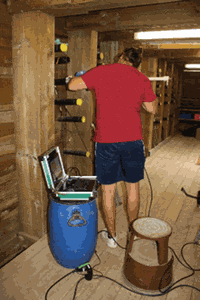Lärm L, Weihermüller L, Rödder J, van der Kruk J, Vereecken H, & Klotzsche A (2024) Spatial variability of hydraulic parameters of a cropped soil using horizontal crosshole ground penetrating radar. Vadose Zone Journal, e20389. doi: 10.1002/vzj2.20389
Nguyen TH, Lopez G, Seidel SJ, Lärm L, Bauer FM, Klotzsche A, Schnepf A, Gaiser T, Hüging H, Ewert F (2024) Multi-year aboveground data of minirhizotron facilities in Selhausen. Scientific Data 11. doi: 10.1038/s41597-024-03535-2.
Nguyen TH, Gaiser T, Vanderborght J, Schnepf A, Bauer F, Klotzsche A, Lärm L, Hüging H, and Ewert F (2024) Responses of field-grown maize to different soil types, water regimes, and contrasting vapor pressure deficit, EGUsphere [preprint], doi:10.5194/egusphere-2023-2967, [ACCEPTED FOR PUBLICATION]
Lärm L, Bauer FM, van der Kruk J, Vanderborght J, Morandage S, Vereecken H, Schnepf A, Klotzsche A (2024) Linking horizontal crosshole GPR variability with root image information for maize crops. Vadose Zone Journal 23. doi: 10.1002/vzj2.20293.
Lärm L, Bauer FM, Hermes N, van der Kruk J, Vereecken H, Vanderborght J, Nguyen TH, Lopez G, Seidel SJ, Ewert F, Schnepf A, Klotzsche A (2023) Multi-year belowground data of minirhizotron facilities in Selhausen. Scientific Data 10. doi: 10.1038/s41597-023-02570-9.
Bauer FM, Lärm L, Morandage S, Lobet G, Vanderborght J, Vereecken H, Schnepf A (2022) Development and Validation of a Deep Learning Based Automated Minirhizotron Image Analysis Pipeline. Plant Phenomics 2022. doi: 10.34133/2022/9758532.
Morandage S, Vanderborght J, Zörner M, Cai GC, Leitner D, Vereecken H, Schnepf A (2021) Root architecture development in stony soils. Vadose Zone Journal 20. doi: 10.1002/vzj2.20133.
Klotzsche A, Lärm L, Vanderborght J, Cai GC, Morandage S, Zörner M, Vereecken H, van der Kruk J (2019) Monitoring Soil Water Content Using Time-Lapse Horizontal Borehole GPR Data at the Field-Plot Scale. Vadose Zone Journal 18. doi: 10.2136/vzj2019.05.0044.
Sulis M, Couvreur V, Keune J, Cai GC, Trebs I, Junk J, Shrestha P, Simmer C, Kollet SJ, Vereecken H, Vanderborght J (2019) Incorporating a root water uptake model based on the hydraulic architecture approach in terrestrial systems simulations. Agricultural and Forest Meteorology 269: 28-45. doi: 10.1016/j.agrformet.2019.01.034.
Cai GC, Morandage S, Vanderborght J, Schnepf A, Vereecken H (2018) "Construction of Minirhizotron Facilities for Investigating Root Zone Processes" and "Parameterization of Root Water Uptake Models Considering Dynamic Root Distributions and Water Uptake Compensation" (vol 17, 170201, 2018). Vadose Zone Journal 17.
Cai GC, Vanderborght J, Couvreur V, Mboh CM, Vereecken H (2018) Parameterization of Root Water Uptake Models Considering Dynamic Root Distributions and Water Uptake Compensation. Vadose Zone Journal 17. doi: 10.2136/vzj2016.12.0125.
Cai GC, Vanderborght J, Langensiepen M, Schnepf A, Hüging H, Vereecken H (2018) Root growth, water uptake, and sap flow of winter wheat in response to different soil water conditions. Hydrology and Earth System Sciences 22: 2449-2470. doi: 10.5194/hess-22-2449-2018.
Cai GC, Vanderborght J, Klotzsche A, van der Kruk J, Neumann J, Hermes N, Vereecken H (2016) Construction of Minirhizotron Facilities for Investigating Root Zone Processes. Vadose Zone Journal 15. doi: 10.2136/vzj2016.05.0043.
Garré S, Pagès L, Laloy E, Javaux M, Vanderborght J, Vereecken H (2012) Parameterizing a Dynamic Architectural Model of the Root System of Spring Barley from Minirhizotron Data. Vadose Zone Journal 11. doi: 10.2136/vzj2011.0179.







